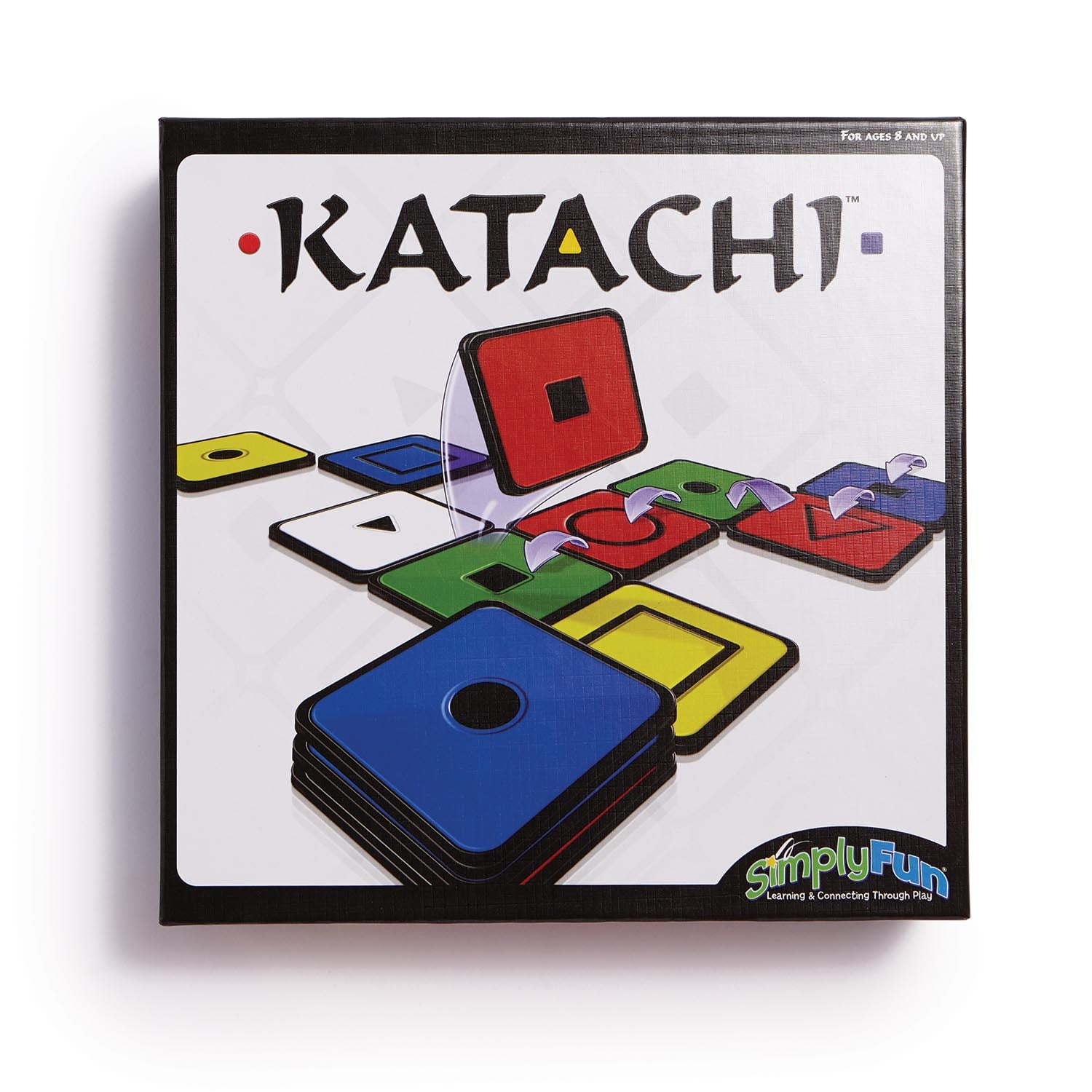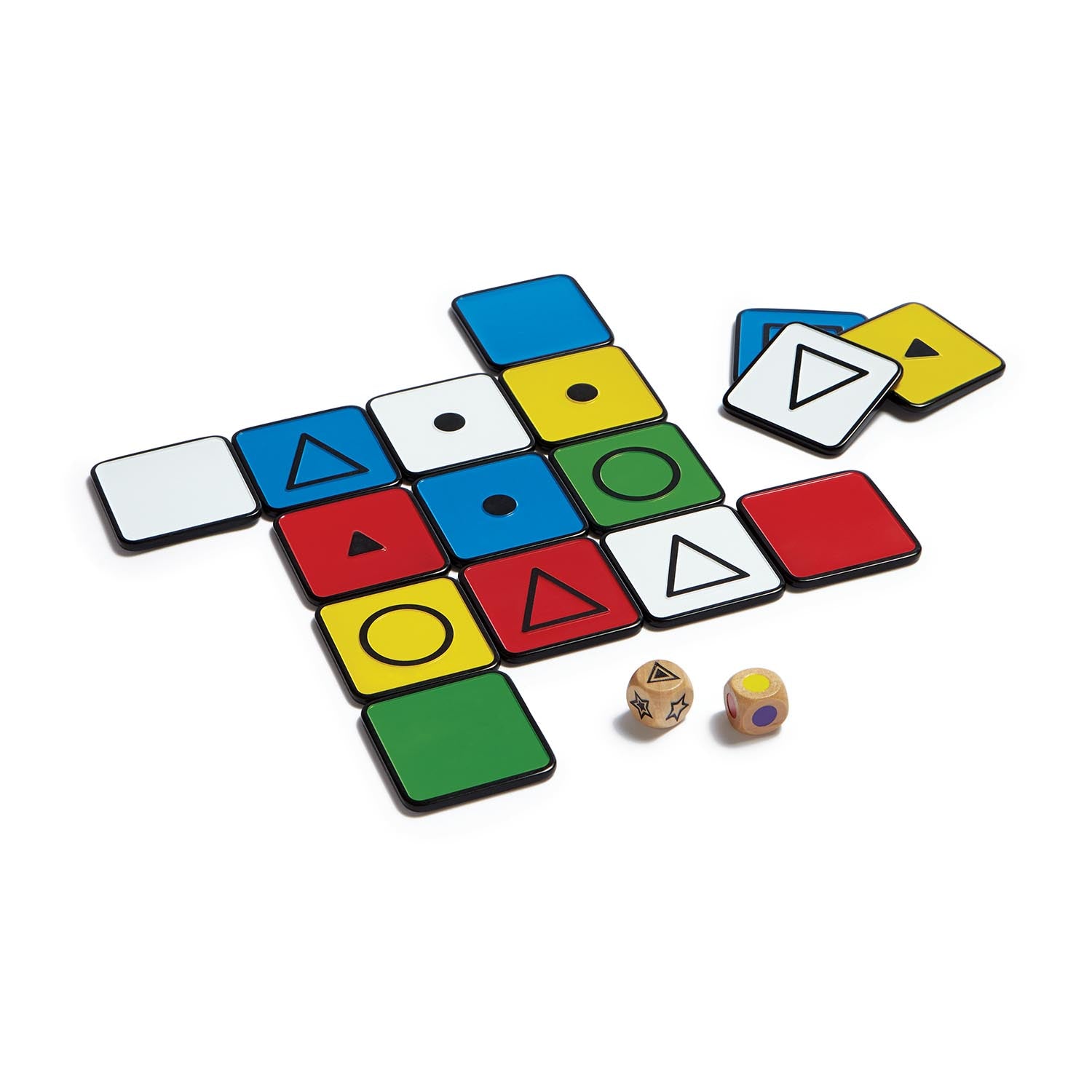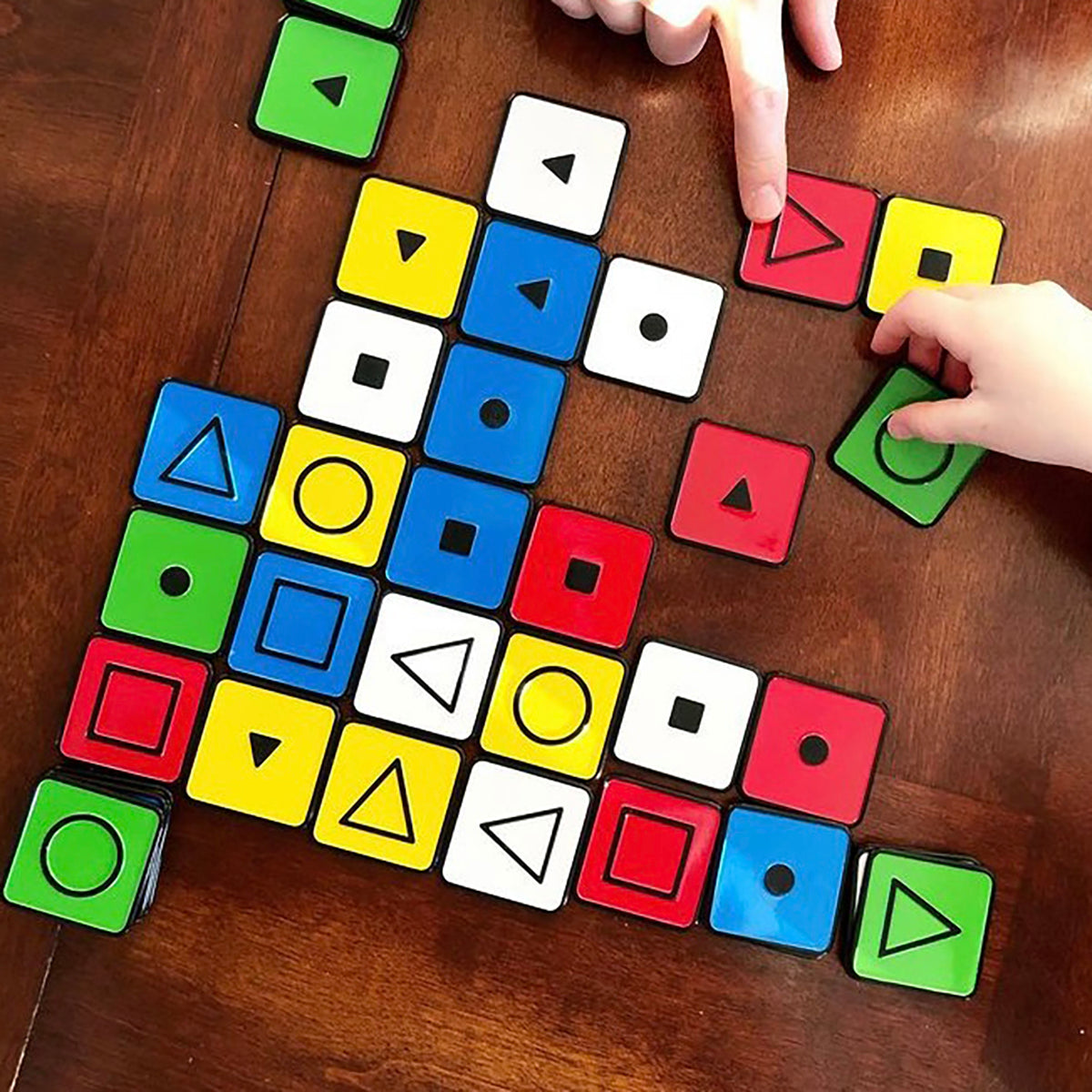Katachi
Katachi
2-4 players • 30 min • 8 & up
Focus: Strategy
Couldn't load pickup availability
Think matching colors, shapes, and sizes is a breeze? Try handling multiple matches at once! Sharpen your spatial reasoning and planning skills as you strategize and move your tiles across the grid to reach your goal. Let the challenge begin!
Skills: Matching, Spatial Reasoning, Planning
Game Includes
Game Includes
- 40 Shape Tiles
- 5 Ladder Tiles
- 1 Color Die
- 1 Shape Die
- 1 Cloth Bag
- 1 Rules Booklet
Share
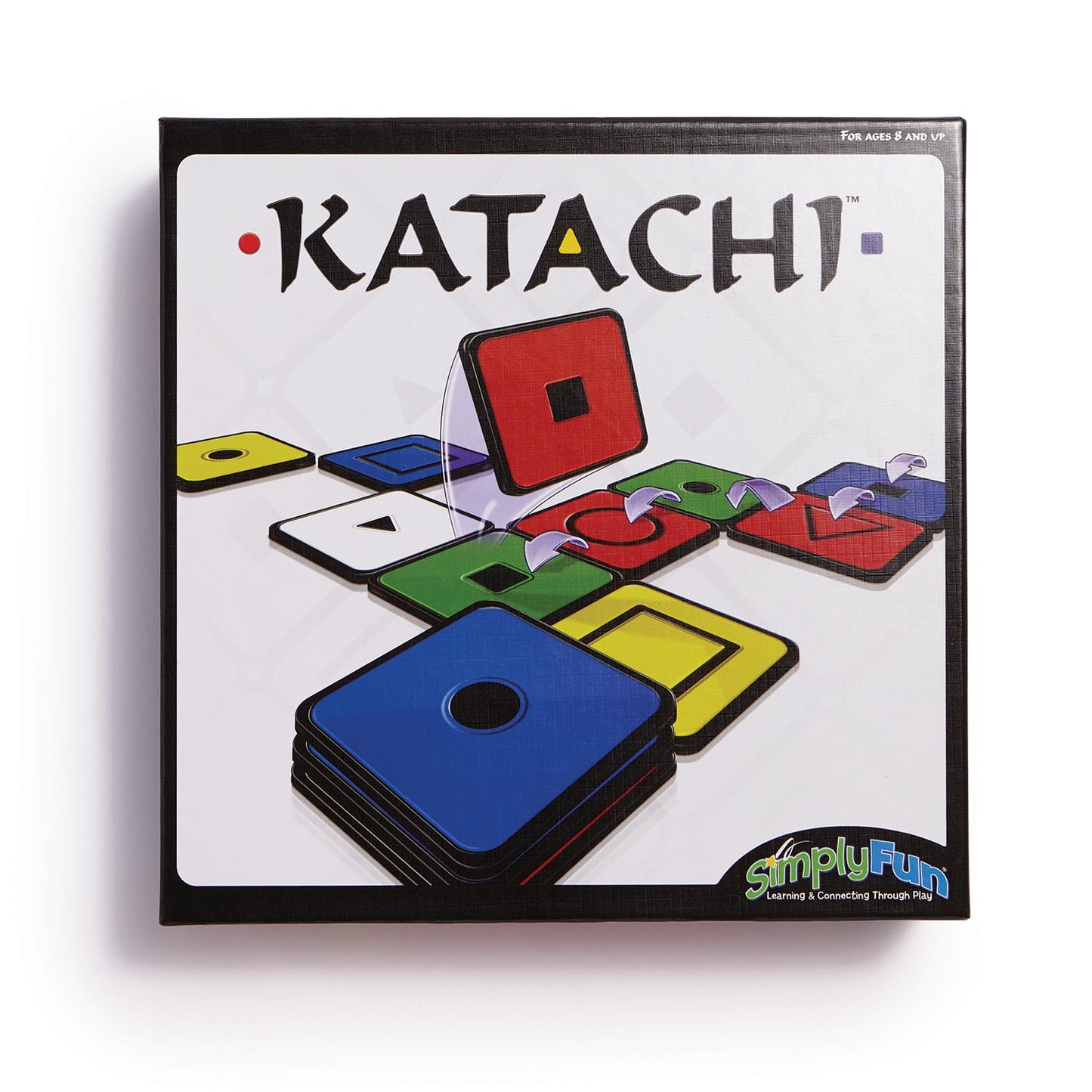
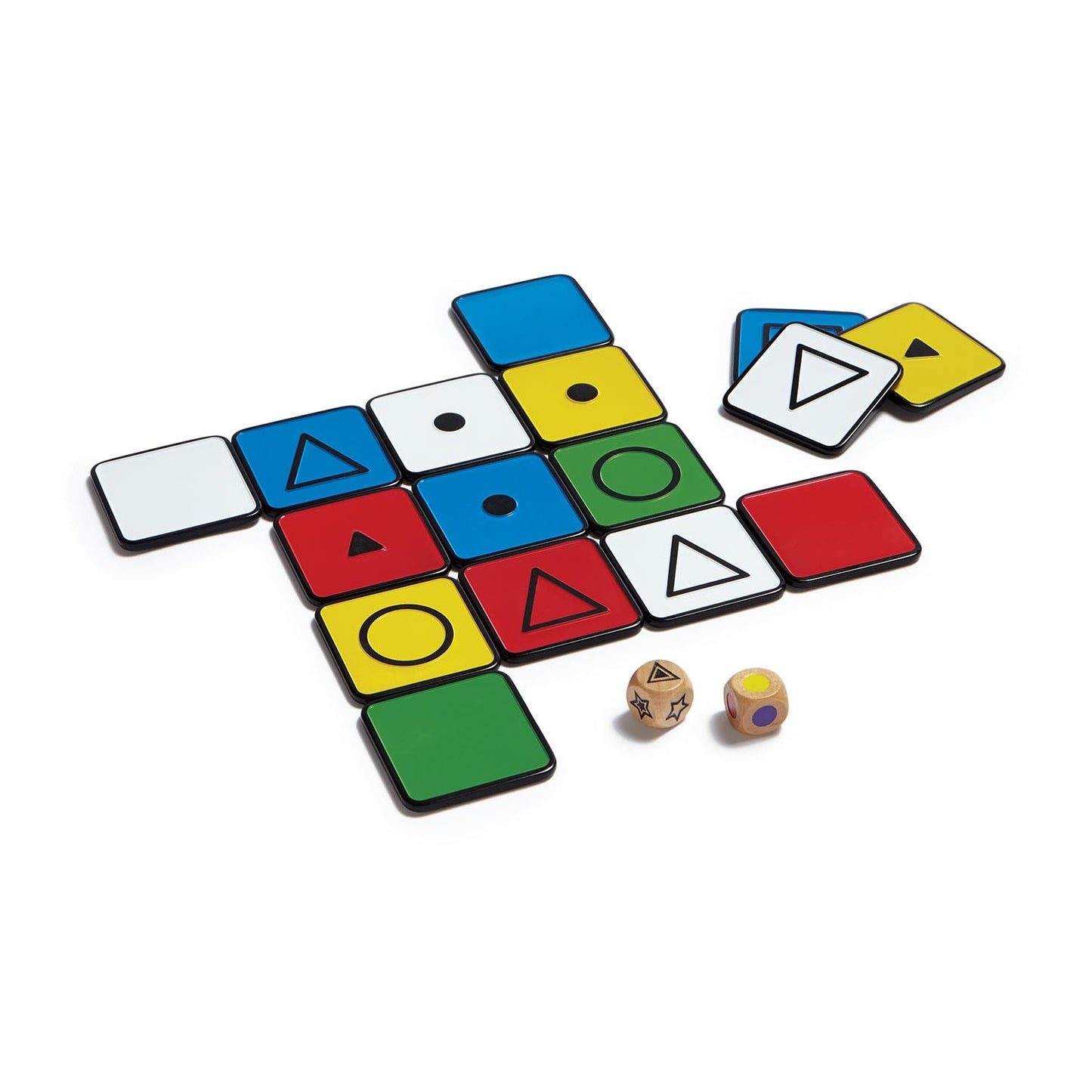
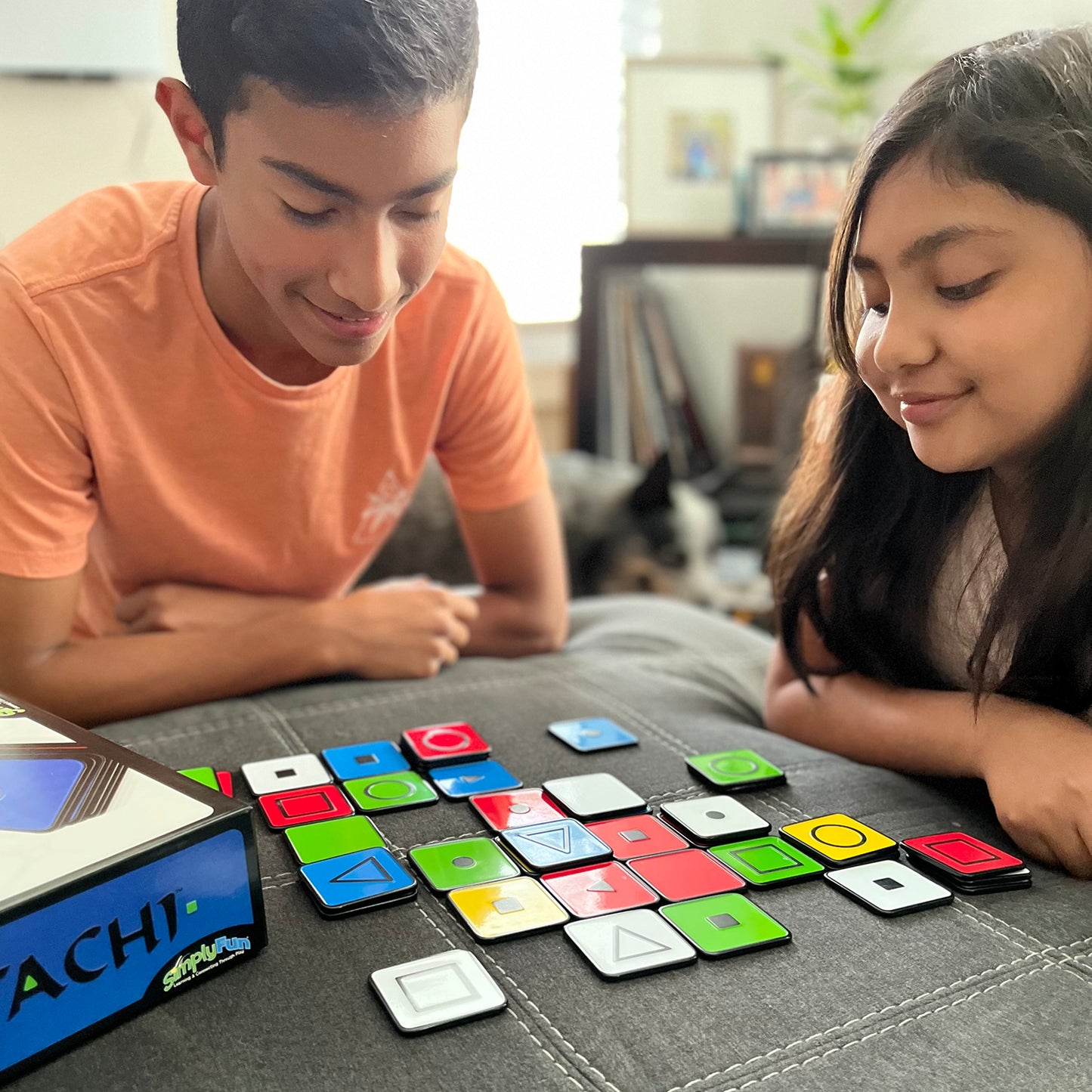
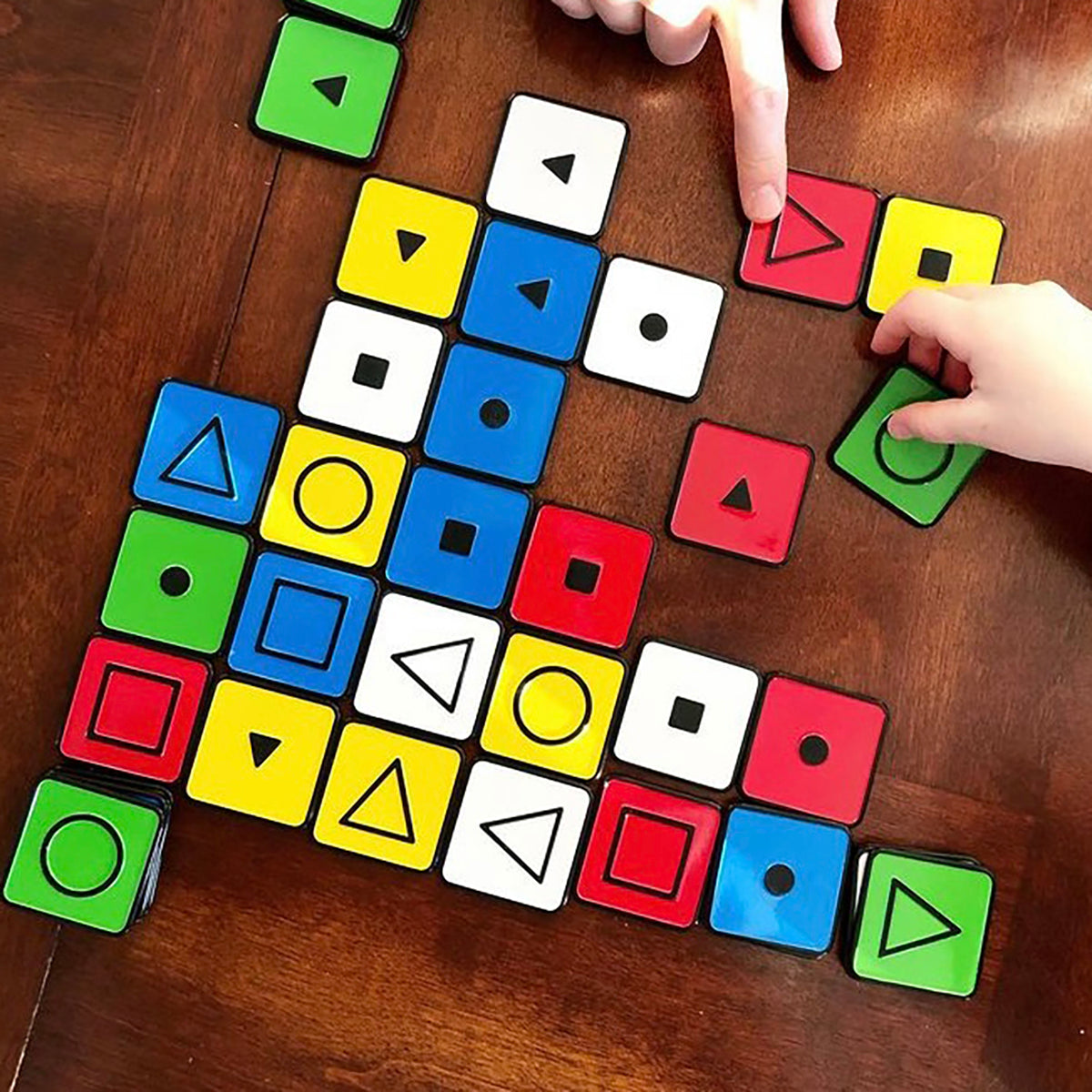


Collapsible content
How to Play
Educational Standards
Core Standard*: Math
Math
- Operations and Algebraic Thinking
- Generate and analyze patterns. Grade Level 4th
- Analyze patterns and relationships. Grade Level 5th
- Geometry
- Reason with shapes and their attributes. Grade Levels 3rd
- Mathematical Practice
- Make sense of problems and persevere in solving them. Grade Level 3rd, 4th, 5th
- Attend to precision. Grade Level 3rd, 4th, 5th
Skills
Explore
What Does Child Do To Use Skill In The Game?
Players explore the arrangement of tiles on the playing field looking for potential sequences, openings and options for moving tiles.
How Parents Can Assist Learning
Remind children to look at all the potential tiles they can move on their turn. This will encourage patience and discourage impulsivity. As children get more advanced at playing Katachi, encourage them to look at their opponents' stack of tiles as well as nearby tiles and empty spaces.
Learning Implications and Educator Support
Remind children to look at all the potential tiles they can move on their turn. This will encourage patience and discourage impulsivity. As children get more advanced at playing Katachi, encourage them to look at their opponents' stack of tiles as well as nearby tiles and empty spaces.
Determine
What Does Child Do To Use Skill In The Game?
Katachi requires a high degree of determining as players examine the arrangement of tiles on the playing field, including opponents' tile stacks, in order to decide what possible moves they can make.
How Parents Can Assist Learning
Katachi involves examining the playing field and creating mental models of the consequences of moving different tiles. When first learning to play, children will think about consequences of the immediate move. As they become more proficient, children will think about one or more moves ahead in order to evaluate what tile would be best to move on their turn for either offensive or defensive purposes.
Learning Implications and Educator Support
Katachi involves examining the playing field and creating mental models of the consequences of moving different tiles. When first learning to play, children will think about consequences of the immediate move. As they become more proficient, children will think about one or more moves ahead in order to evaluate what tile would be best to move on their turn for either offensive or defensive purposes.
Compare
What Does Child Do To Use Skill In The Game?
Katachi requires a high level of comparing. Players will create mental models of the outcomes for moving different pieces. Based on those models, they will compare to determine the best move.
How Parents Can Assist Learning
Making mental models of sequences is an advanced, complex cognitive skill that supports learning spatial relations, pattern recognition and creative problem solving. To help children learn these skills, ask them to describe aloud the different sequences they can make and the potential consequences for themselves and opponents for each sequence.
Learning Implications and Educator Support
Making mental models of sequences is an advanced, complex cognitive skill that supports learning spatial relations, pattern recognition and creative problem solving. To help children learn these skills, ask them to describe aloud the different sequences they can make and the potential consequences for themselves and opponents for each sequence.
Remember
What Does Child Do To Use Skill In The Game?
Players need to remember what the die symbols mean and how many characteristics need to match for a successful move.
How Parents Can Assist Learning
If children have difficulty remembering, make a copy of the instructions for them to use as they play. This is particularly useful as children learn the game.
Learning Implications and Educator Support
If children have difficulty remembering, make a copy of the instructions for them to use as they play. This is particularly useful as children learn the game.
Predict
What Does Child Do To Use Skill In The Game?
Players are consistently thinking about what their opponents may do in response to their move. They will make mental models to predict the outcome of moving a tile, considering the offensive benefit to the player and the defensive effect on opponents.
How Parents Can Assist Learning
Katachi helps develop strategic thinking based on risk/reward analysis of different options. To help children predict, ask them to share different moves they are considering and what they think an opponent might move in response. Young children are learning how to do this, and therefore, may need tangible support. Prior to making their final decision, allow them to move tiles around the playing field to examine different sequences and potential effects on opponents.
Learning Implications and Educator Support
Katachi helps develop strategic thinking based on risk/reward analysis of different options. To help children predict, ask them to share different moves they are considering and what they think an opponent might move in response. Making mental models also helps develop spatial reasoning. Young children are learning how to do this, and therefore, may need tangible support. Prior to making their final decision, allow them to move tiles around the playing field to examine different sequences and potential effects on opponents.
Plan
What Does Child Do To Use Skill In The Game?
Planning is a key skill used and developed in this game. Players on constantly examining the board and the moves of opponents in order to decide on their next move and subsequent moves
How Parents Can Assist Learning
Encourage children to pay attention to the tiles other players are moving and how close they are to winning. Also, remind children that they can choose to not move on a turn. This helps them consider non-action as an element of strategic planning.
Learning Implications and Educator Support
To be successful in this game requires thinking about consequences beyond a player's immediate move. This type of long-term, sequential thinking is important well beyond game play such as for high level math, planning a day's events or playing most sports. Also, remind children that they can choose to not move on a turn. This helps them consider non-action as an element of strategic planning.
Experiment
What Does Child Do To Use Skill In The Game?
As the game progresses, players will likely change approaches throughout the game from offensive (attempting to make a make their stacks) and defensive (preventing others from making their stacks). Ultimately, the player that finds the right balance will win the game by making building their stacks first.
How Parents Can Assist Learning
This game involves solving two problems at once. First is how to make stacks in your corner. Second is how to prevent other's from making similar stacks. Thus, there are different approaches and strategies. Discuss different strategies prior to starting the game. Play the game and discuss. Then, play again with the child trying different approaches and strategies. Discuss again and compare the advantages and disadvantages. Once children understand different strategies, they can shift and adapt strategies within a game.
Learning Implications and Educator Support
This game involves solving two problems at once. First is how to make stacks in your corner. Second is how to prevent other's from making similar stacks. Thus, there are different approaches and strategies. Discuss different strategies prior to starting the game. Play the game and discuss. Then, play again with the child trying different approaches and strategies. Discuss again and compare the advantages and disadvantages. Once children understand different strategies, they can shift and adapt strategies within a game.
In particular, have children try moving tiles that are close to their opponents, creating empty spaces. This is a defensive strategy that the children can experiment with.
Practice
What Does Child Do To Use Skill In The Game?
Players will increase proficiency the more they play Katachi.
How Parents Can Assist Learning
Katachi has many levels of mastery. Therefore, the more children play the more capable they will be in developing and executing increasingly sophisticated strategies. Also, as they become proficient, they will be able to teach others. Teaching others demonstrates mastery, is wonderful for building self-esteem and is essential to intrinsic motivation.
Learning Implications and Educator Support
Katachi has many levels of mastery. Therefore, the more children play the more capable they will be in developing and executing increasingly sophisticated strategies. Also, as they become proficient, they will be able to teach others, demonstrating their mastery.
Solve
What Does Child Do To Use Skill In The Game?
As the game progresses, players will learn new information and adapt their strategies to the moves of opponents. The winning player will make two stacks in their corner prior to opponents.
How Parents Can Assist Learning
After children have mastered the rules and functions of the dice and tiles, they learn new information constantly during game play. This information directly effects how children strategize an approach for moving tiles, and ultimately solve the game. Encourage children to remain flexible in their approach to the game. Because there are so many options and an element of chance (i.e. the dice), it is difficult to predict what opponents will do. Thus, it is important to adapt based on prior moves.
Learning Implications and Educator Support
This game involves uses of visual spatial problem solving, directionality and if/then problem solving. After children have mastered the rules and functions of the dice and tiles, they learn new information constantly during game play. This information directly effects how children strategize an approach for moving tiles, and ultimately solve the game. Encourage children to remain flexible in their approach to the game. Because there are so many options and an element of chance (i.e. the dice), it is difficult to predict what opponents will do. Thus, it is important to adapt based on prior moves. Adapting is key to building resilience and creative problem solving.
Review
What Does Child Do To Use Skill In The Game?
Players will often reflect back on choices they made.
How Parents Can Assist Learning
Although not required, it is fun to discuss activities after they are complete. What worked? What was hard?
Learning Implications and Educator Support
Although not required, it is fun to discuss activities after they are complete. What worked? What was hard? Analysis of process can help children learn from each other.
Demonstrate
What Does Child Do To Use Skill In The Game?
Performers will demonstrate through words, physical motion, drawing, sounds and facial expressions in an effort to get their teammates to make accurate guesses.
Players may demonstrate if encouraged. See How Parents Can Assist Learning.
How Parents Can Assist Learning
When a child moves a tile and an opponent responds in an unexpected way, ask the child to share how they decided to make their prior move. Help the child examine their thinking, identifying areas where they be able to consider options and potential consequences more thoroughly on future turns.
During or after the game, discuss moves and what worked and did not work as expected.
Learning Implications and Educator Support
When a child moves a tile and an opponent responds in an unexpected way, ask the child to share how they decided to make their prior move. Help the child examine their thinking, identifying areas where they be able to consider options and potential consequences more thoroughly on future turns.
During or after the game, discuss moves and what worked and did not work as expected.
*Data compiled from CCSSI ELA Standards, WA Science Standards, and Washington Social Studies Standards
Special Needs
Cognitive
Suggestions for How to Modify Play Experience
Katachi involves matching in order to build sequences and establish winning strategies. For children with cognitive delays, play the Game Variant in the instructions first. With this modification, the child only need to consider one characteristic (color) when beginning a turn. After the child understands the Game Variant, try playing with only the Shape Die. This introduces two characteristics (shape and size) when beginning a turn. After the child masters the Shape Die, then use both dice.
If a child has difficulty understanding what a star on the Shape Die means, have themr re-roll until a shape (circle, square or triangle) is rolled face up.
Communication
Suggestions for How to Modify Play Experience
Children with language comprehension issues may find the directions difficult to understand. Clarify the rules by demonstrating how to match a single characteristic to move horizontally or vertically and to match two characteristics to move diagonally. A visual explanation in addition to verbal will make the rules easier to understand. Encourage the child to demonstrate an example as well. This will enable the adult to see if the rules are understood.
Have children work in pairs. If possible, have a more advanced player teamed with a less advanced player. Working as a team will require children to discuss their strategy and examine different sequences together.
To encourage communication and language production, ask children to explain their strategy at each turn. Discuss other options with all the players. This can be done either before or after a turn. This increases conversational abilities as each player offers an opinion about a move. This approach gives children practice in conversation, and also enhances comprehension of complex language structures. The visual stimulus of the board reinforces the comprehension. Comprehension of complex language structure is necessary for reading comprehension.
Sensorimotor
Suggestions for How to Modify Play Experience
The tiles are large, therefore, most children should be able to manipulate them. If they are too difficult to pick up, spread the tiles apart from each other so there is room between each tile.
Play in teams. The child with sensorimotor issues helps think about strategy and decide on moves to make. The other teammate can move the tiles on the playing field.
Social Emotional/Behavioral
Suggestions for How to Modify Play Experience
Team play is recommended for children with low frustration tolerance and/or attention issues. In a team format, children will be able to help each other think through the options regarding their strategy, which sequences are possible and which tiles to more. Encourage players to discuss the justification for their ideas at each turn. This process builds negotiation skills.
If novice players are playing against more advanced opponents, allow the novice players to win if they get stack one fewer than opponents on the corner tile. This will help level the game, therefore, novice players are more likely to win. Winning can support intrinsic motivation to keep playing and improving their skills.
If children are playing independently, support them by having them explain their thinking before they move. Discuss options that they may not have considered.
Vision
Suggestions for How to Modify Play Experience
No special modifications required.
Hearing
Suggestions for How to Modify Play Experience
No special modifications required.
*Data compiled from CCSSI ELA Standards, WA Science Standards, and Washington Social Studies Standards
Autism
Autism Strengths & Interests
Short Summary of Strengths & Interests
- Is good at seeing patterns and sequences.
- Can think about 3 variables at the same time.
- Prefers activities that are very concrete and tactile.
Is good at matching visual items
Is This Game Appropriate? Yes
Description
Katachi is a game of visual matching. Players match the symbols on the dice to find corresponding matches on the board tiles. As there are three potential matches (e.g., color, shape, and size) for each tile, children who can keep these 3 variables in mind for a match will enjoy this game.
Has a good memory for sensory details, including visual, touch, taste and smell
Description VERBIAGE GOES HERE
Has a good memory for words, phrases and dialouge
This game is not appropriate
Has a good memory for pictures, numbers and patterns
Is This Game Appropriate? Yes
Description
Each tile on the board has a color, shape, and size. The tile being moved also has a color, shape and size. Players need to be able to ignore the irrelevant characteristics of a tile to find a match for at least one characteristic to be able to move their tile on the board. This requires the ability to observe the various patterns and then select one or more relevant characteristics during each turn.
Likes to put things in order or a sequence
Is This Game Appropriate? Yes
Description
Children create their own sequence of movements on the board by making matches in sequence. Children who like to create their own path will enjoy this game.
Learns through visualizing or "replaying" actions in their mind
Is This Game Appropriate? Yes
Description
Children visualize various paths prior to moving their tile. This enables them to select the best option for reaching their goal.
Likes activities with rules, such as math and phonics
Is This Game Appropriate? Yes
Description
The rules are simple in Katachi, so if the child is able to focus on identification of a shape, size and/or color match, the game will be easy to understand.
Is very concrete and literal
Is This Game Appropriate? Yes
Description
All of the characteristics of the tiles are clearly seen. The only abstract elements are symbols for any size, shape or color. With prompting for these abstract symbols, children with autism should be able to understand the elements of the tiles.
Learns in small "chunks" (for example, phone numbers are 3 chunks of number xxx-xxx-xxxx that are combined together)
This game is not appropriate
Is good at nonverbal reasoning and logic
This game is not appropriate
Likes spatial problem solving
Is This Game Appropriate? Yes
Description
Children with autism often have an ability to see spatial relationships. In Katachi the child needs to combine characteristics of the tiles with the spatial relationships to create a path to the goal. If they can keep all elements in mind, they will do well with this game.
Can read well with good vocabulary, though may not fully comprehend content
This game is not appropriate
Likes to use and has good fine motor skill
This game is not appropriate
Likes established routines or set ways of doing things
This game is not appropriate
Likes manipulating, constructing or building things
This game is not appropriate
Likes to use and has good musical abilities
This game is not appropriate
Likes to use and has good drawing skills
This game is not appropriate
Autism Special Considerations
Appears to ignore other's communication and/or has difficulty giving eye contact to a communication partner
Is This Game Appropriate for Child with Characteristic? Yes
Can Child with Characteristic Play Game w/o Modification? Yes
Strategies for Developing Compensatory Skills:
Look at the game instead of each other.Person talking holds the object being talked about near their mouth to bring the child's attention to the object. This also shows the child how the words about the object are produced. For example, hold a game tile up by the mouth, and say its characteristics, "Large, blue, square."
Has difficulty understanding complex verbal directions
Is This Game Appropriate for Child with Characteristic? No
Can Child with Characteristic Play Game w/o Modification?
Strategies for Developing Compensatory Skills:
Directions for Katachi are complex and require being able to focus on multiple attributes at one time. Katachi may not be appropriate for children who have difficulty with these issues.
Uses vocabulary inaccurately or demonstrates echolalia (repeating another's speech)
Is This Game Appropriate for Child with Characteristic? Yes
Can Child with Characteristic Play Game w/o Modification? Yes
Strategies for Developing Compensatory Skills:
Respond to immediate echolalia (repeating what was just said) by rephrasing the child's response into a correct format, so the child can hear and repeat that phrase. For example, assume you are playing with a child named Andy and you say, "Your turn," and Andy repeats, "Your turn." You can say, "It's Andy's turn. You say, my turn." This allows the child to hear and repeat the correct response. Eventually, the child will pick up the pattern of response.
Delayed echolalia (repetition of previously heard comments) may have a hidden meaning or association. Look for connection in the phrase used to the current situation. For example, the child says, "After these messages we'll be right back!" Think what the repeated phrase is associated with for the child. Try to interpret what is meant and rephrase it for the child. For example, you might respond by saying, "It sounds like you want a break for a few minutes. Is that what you mean? You can tell me, 'I need a break.'"
Gets stuck repeating a verbal topic or physical actions and/or has difficulty attending to others' actions or topic.
Is This Game Appropriate for Child with Characteristic? Yes
Can Child with Characteristic Play Game w/o Modification? Yes
Strategies for Developing Compensatory Skills:
Incorporate a preferred topic into the game to increase motivation. For example, if the child is fixated on a particular character, like a favorite super hero, ask what the character would do if they were playing?
Practice phrases for commenting on others' play actions. For example, you say to Joe (who is playing with you), "Right on!" Then ask the child, "What did Joe do? " Remind children about listening and watching others' before making their own comment or action.
Use a motivation toy or object to gain the child's attention. For example, a preferred wind-up toy can be placed on the board when it is the child's turn. The child gets to wind up the toy after completing their turn.
Use the child's finger to point to what needs attention. They will attend to their finger first, and then the adult can point out the object they are pointing at. Extend the child's action to make a correct response.
Reinforce attention and actions by commenting on what was done correctly.
Has difficulty producing speech/communication
Is This Game Appropriate for Child with Characteristic? Yes
Can Child with Characteristic Play Game w/o Modification? Yes
Strategies for Developing Compensatory Skills:
The game can be played without the child producing speech, but s/he must comprehend language well.
Has difficulty sequencing multi-step actions and/or doing complex abstract tasks
Is This Game Appropriate for Child with Characteristic? No
Can Child with Characteristic Play Game w/o Modification? No
Strategies for Developing Compensatory Skills:
Not recommended for children with this characteristic.
Demonstrates difficulty initiating and maintaining social interactions
Is This Game Appropriate for Child with Characteristic? Yes
Can Child with Characteristic Play Game w/o Modification? Yes
Strategies for Developing Compensatory Skills:
Develop a social story to be read at the start of a game. A social story is a short booklet that illustrates how a child can use positive social skills. It includes two to five descriptive statements and a directive statement. For example: "When I watch others, I will know when it is my turn. Others like me when I take turns. I will watch what others do with their pieces and listen to what they say. Others like it when I talk about the game." Add photos or drawings of the child doing the actions described in the story.
Role play social situations and reinforce appropriate words and actions. For example, role play commenting on another player's turn. For instance, "You went really far." Use video feedback of positive social behaviors. Video of actual play enables children to see what they or others did. Appropriate actions and interactions can then be discussed.
Acts out or demonstrates avoidance behaviors when frustrated, overwhelmed, or needs more sensory input.
Is This Game Appropriate for Child with Characteristic? Yes
Can Child with Characteristic Play Game w/o Modification? No
Strategies for Developing Compensatory Skills:
Reduce extraneous noise or allow the child to wear head phones or ear plugs if loud sounds cause anxiety. A weighted vest worn during the game may provide additional pressure input and thus reduce fidgeting due to sensory needs. Pressure can be calming when used for no more than 20 minutes at a time.
Practice a phrase to ask for help and role play situations in the game where it is needed.
Provide techniques for self-calming, such as holding a special toy.
Allow time for movement. For example, a child who needs to move frequently can be given an opportunity to 'celebrate' their turn by running around the table or jumping up and down 10 times.
Has short attention span for non-preferred activities
Is This Game Appropriate for Child with Characteristic? No
Can Child with Characteristic Play Game w/o Modification? No
Strategies for Developing Compensatory Skills:
Unless visual spatial games are a preference, this game is not recommended. It requires focused attention.
Needs sameness or consistent routines and/or has difficulty with transitions from one activity to another
Is This Game Appropriate for Child with Characteristic? Yes
Can Child with Characteristic Play Game w/o Modification? No
Strategies for Developing Compensatory Skills:
Play games at the same time every day, so the child anticipates the game routine.
Change the location of the game, so the child may play in different rooms, at the table, or on the floor. This will build tolerance for variation.
Prepare the child ahead time for the introduction of a new game. Talk about aspects that will be motivating for the child, and let them explore the parts of the game before setting out the whole game.
Provide a structure for placement of game pieces that can be the same each time the game is played. For example, have a specific location for where the board goes, the pieces, etc.
Provide choices for how the child can be involved in set up or clean up. For example, you might ask, " Do your want to lay out the red or blue tiles?" Involve the child verbally and with actions for the transition to the game table or at the end of game play. For example, you might say, "Let's look at the pictures on the game box and guess what it is about."
Use an object cue. Let the child hold an object from the game or activity you want to introduce prior to the transition. For example, if you were intending to play Katachi, you would hand the child a tile from the game and say, "Look here is a tile What game does it go with?"
Has difficulty understanding others' feelings, intentions, and the reasons for others' actions.
Is This Game Appropriate for Child with Characteristic? Yes
Can Child with Characteristic Play Game w/o Modification? No
Strategies for Developing Compensatory Skills:
Model and point out what others are feeling and comment on their facial expressions or words.
Discuss what causes feelings in others. For example, "You are happy because you got a tile to your corner tile . But, look at Joe's face. He is not happy because he is stuck behind a blank hole."
Ask child to explain their own feelings and intentions.
Ask child to explain why other players did specific actions in the game.
*Data compiled from CCSSI ELA Standards, WA Science Standards, and Washington Social Studies Standards
Extended Play
Extra Ways to Play the Game
Try playing Katachi as a head-to-head game. Each player selects 16 tiles and arranges them in a 4 x 4 grid. Each player places one other tile as their corner tile. Then, one player rolls the dice. Both players use the same roll of the dice to move (or opt not to move) a tile on their own playing field. After both players complete their turn, the second player rolls the dice and so on. The goal is to make a stack of 7 tiles on the corner tile before your opponent does. All other rules apply.
Materials Needed
No additional materials required.
Developmental Benefits
This variation has the same benefits as the basic game play, but introduces a different way to play in order to build more interest in repeat play. The more that children play Katachi, the more they will learn strategic thinking.
Extra Ways to Play the Game
To make the game a little more simple, try playing with only the Shape Die. This introduces two characteristics (shape and size) when beginning a turn, rather than three characters. After the child masters the Shape Die, then use both dice.
Materials Needed
No additional materials required.
Developmental Benefits
It is important for building confidence and motivation that an activity is not so difficult as to be frustrating. This modifications allows children to learn one aspect of the game prior to moving on to more complex play with both dice.
Extra Ways to Play the Game
Play a memory game with the tiles. Turn them all over and arrange them in a grid. Turn over two tiles. If they match, remove them from the playing field. The game ends when no more tiles remain or can be matched. The person with the most tiles wins. When first playing, try matching just color. Then match shape; match size; and lastly, match shape and size.
Materials Needed
No additional materials required.
Developmental Benefits
This modification builds visual spatial memory, a cognitive skill. It also builds memory by laddering difficulty.
*Data compiled from CCSSI ELA Standards, WA Science Standards, and Washington Social Studies Standards
Collapsible content
How to Play Video & Transcript
Today, we’ll learn how to play Katachi, Simply Fun’s unique geometric strategy game that teaches about sequences and how objects can be grouped by their similarities. Katachi means “the ideal shape or form” and that’s just what players are looking for as they walk tiles back to their home corners.
Katachi is for 2 to 4 players ages 8 and up.
Each Katachi box includes:
• forty Shape tiles
• five Ladder Tiles
• one Color die
• one Shape die
• one cloth bag, and
• one rules booklet
Katachi is a great game for developing analytical, problem solving and pattern matching skills. Players look for connections between shapes, sizes and colors, and look for ways objects can be interrelated in multiple ways to move their piece ahead.
To set up the game, remove the 5 ladder tiles (solid color tops) from the cloth bag and place them back in the game box. These are used for alternative play. Set up the playing field by forming a 6 by 6 square of randomly placed shape tiles, shown face up. There will be 4 shape tiles left over. Place each of the leftover tiles in one corner, as shown (for a 4 player game). The corner tile is the home base for your winning 3-tile stack.
When playing with 2 or 3 players, place the corner tiles like this and put any extras back in the box.
The object of the game is to “walk” tiles to your home corner by following the correct paths across the playing field. Be the first player to stack three shape tiles on top of your corner tile, AND have at least two shape tiles stacked on a tile adjacent to your corner tile, and you are the winner!
A quick word about characteristics: the Color die determines the color of the shape tile to be selected, while the Shape die determines both the shape – and the size of the shape – you must match. The purple color is WILD, and allows you to choose any color of the shape tile you want while the big and small stars allow you to pick any shape of that size you want.
To play, the first player rolls both the dice at the same time. The result of the roll determines which of the tile characteristics must be matched when selecting shape tiles from the playing field.
Select any shape tile in the field (EXCEPT THE CORNER TILES) that has the required characteristics and move this tile toward your own corner tile, or home base.
Rules for moving a shape tile are as follows:
1. You may move the selected tile one step forward, backward or sideways if the tile you will land on has at least one characteristic in common with the tile you are moving. For example, triangle to triangle, big to big, color to color.
2. You may move the selected tile one step diagonally in any direction if the tile you will land on has at least two characteristics in common with the tile you are moving. For example, big and green to big and green.
If you cannot – or choose not – to move your shape tile any further, the tile must be placed on top of a tile that matches at least one characteristic – color, shape or size. It can also be placed in an adjacent empty space, but once placed there the players turn is over as the tile can move no further
Likewise, if a player is unable to move any shape tiles that match his dice, his turn is over and it’s the next player’s turn. This can also be the case if a player is ABLE to move a tile but chooses not to. He simply passes his turn to the next player.
Finally, a player’s turn is over if the shape tile being moved ends on his corner tile/stack. Then play continues with the next player, in a clockwise direction.
The game ends when a player has stacked 3 shape tiles on his corner tile – for a total of 4 tiles AND has at least two shape tiles stacked on the playing field adjacent to his corner tile.
Note: Players MUST stack a shape tile on the tile adjacent to the corner tile before completing the stack of three tiles in the corner.
For more specific variations on Katachi using the Ladder tiles, refer to the rules booklet.
Katachi pairs creativity and logic in a beautiful dance of right brain and left brain activity. “Walk” tiles back to your home corner by matching colors, sizes and shapes, and win by stacking the ‘perfect set of forms!’
Subscribe for More Fun!
Be the first to know about new games, exclusive offers and more.
- YouTube
- TikTok
- X (Twitter)
- Choosing a selection results in a full page refresh.
- Opens in a new window.



